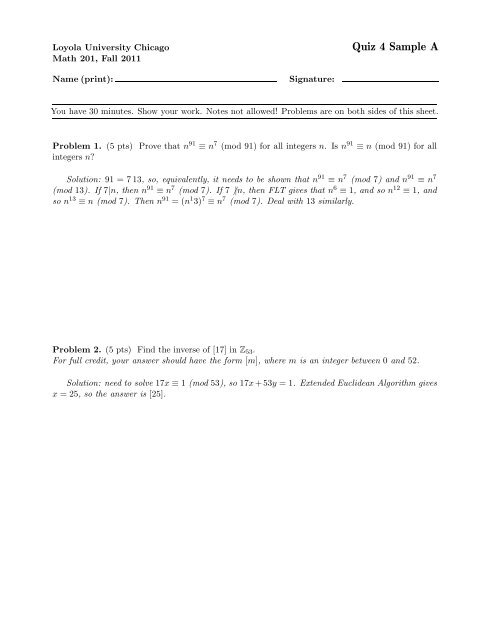Some solutions to Quiz 4 Sample A - Loyola University Chicago
Some solutions to Quiz 4 Sample A - Loyola University Chicago
Some solutions to Quiz 4 Sample A - Loyola University Chicago
- No tags were found...
You also want an ePaper? Increase the reach of your titles
YUMPU automatically turns print PDFs into web optimized ePapers that Google loves.
<strong>Loyola</strong> <strong>University</strong> <strong>Chicago</strong>Math 201, Fall 2011<strong>Quiz</strong> 4 <strong>Sample</strong> AName (print):Signature:You have 30 minutes. Show your work. Notes not allowed! Problems are on both sides of this sheet.Problem 1. (5 pts) Prove that n 91 ≡ n 7 (mod 91) for all integers n. Is n 91 ≡ n (mod 91) for allintegers n?Solution: 91 = 7 13, so, equivalently, it needs <strong>to</strong> be shown that n 91 ≡ n 7 (mod 7) and n 91 ≡ n 7(mod 13). If 7|n, then n 91 ≡ n 7 (mod 7). If 7 ̸ |n, then FLT gives that n 6 ≡ 1, and so n 12 ≡ 1, andso n 13 ≡ n (mod 7). Then n 91 = (n 1 3) 7 ≡ n 7 (mod 7). Deal with 13 similarly.Problem 2. (5 pts) Find the inverse of [17] in Z 53 .For full credit, your answer should have the form [m], where m is an integer between 0 and 52.Solution: need <strong>to</strong> solve 17x ≡ 1 (mod 53), so 17x+53y = 1. Extended Euclidean Algorithm givesx = 25, so the answer is [25].
Problem 3. (5 pts) Solve the simultaneous congruences4x ≡ 3 (mod 7)7x ≡ 47 (mod 23)Solution: in Z 7 , [4] −1 = 2 so 4x ≡ 3 (mod 7) can be rewritten as 2 4x ≡ 2 3, so x ≡ 6 (mod 7).Hence x = 7k + 6, plug this in<strong>to</strong> the second equation, get 7(7k + 6) ≡ 47, 49k + 42 ≡ 47, so 3k ≡ 5(mod 23). Change <strong>to</strong> a Diohpantine equation 3k+23l = 5. Check gcd(3, 23) = 1|5, so <strong>solutions</strong> exist.Guess that 3 8 + 23(−1) = 1 so 3 40 + 23(−5) = 5. Hence, k = 40 is one solution, which gives onesolution x = 7 40 + 6 = 286 <strong>to</strong> the simultaneous congruences. Then all <strong>solutions</strong> are x ≡ 286 (mod161), where 161 = 7 23, which simplifies <strong>to</strong>x ≡ 125 (mod 161).Problem 4. The Chinese Remainder Theorem says the following: If gcd(m 1 , m 2 ) = 1, then, for anya 1 , a 2 ∈ Z, the simultaneous congruences x ≡ a 1 (mod m 1 ), x ≡ a 2 (mod m 2 ) have a solution, andif x = x 0 is one solution than the complete solution is x ≡ x 0 (mod m 1 m 2 ). Use this result <strong>to</strong> provethe following:• If gcd(m 1 , m 2 ) = 1 thenx ≡ a (mod m 1 m 2 ) ⇐⇒{ x ≡ a (mod m1 )x ≡ a (mod m 2 )Solution: see textbook.
















